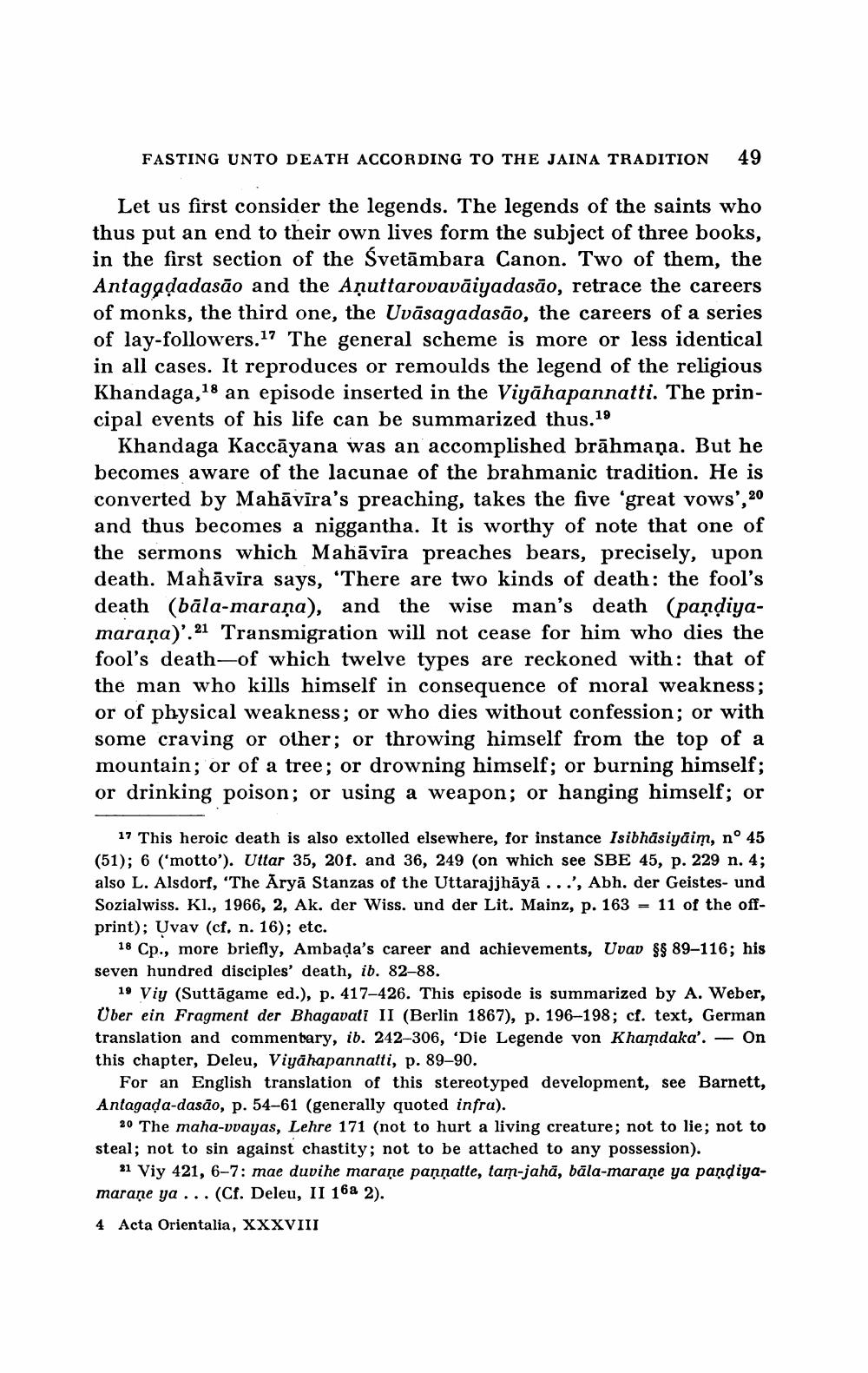Book Title: Fasting Unto Death According To Jaina Tradition Author(s): Colette Caillat Publisher: Colette Caillat View full book textPage 7
________________ FASTING UNTO DEATH ACCORDING TO THE JAINA TRADITION 49 Let us first consider the legends. The legends of the saints who thus put an end to their own lives form the subject of three books, in the first section of the Svetāmbara Canon. Two of them, the Antagadadasāo and the Aņuttarovavāiyadasão, retrace the careers of monks, the third one, the Uvāsagadasão, the careers of a series of lay-followers. 17 The general scheme is more or less identical in all cases. It reproduces or remoulds the legend of the religious Khandaga, 18 an episode inserted in the Viyāhapannatti. The principal events of his life can be summarized thus.19 Khandaga Kaccāyana was an accomplished brāhmaṇa. But he becomes aware of the lacunae of the brahmanic tradition. He is converted by Mahāvira's preaching, takes the five 'great vows',20 and thus becomes a niggantha. It is worthy of note that one of the sermons which Mahāvīra preaches bears, precisely, upon death. Mahāvira says, "There are two kinds of death: the fool's death (bāla-maraņa), and the wise man's death (pandiyamaraņa)'. 21 Transmigration will not cease for him who dies the fool's death of which twelve types are reckoned with: that of the man who kills himself in consequence of moral weakness; or of physical weakness; or who dies without confession; or with some craving or other; or throwing himself from the top of a mountain; or of a tree; or drowning himself; or burning himself; or drinking poison; or using a weapon; or hanging himself; or 17 This heroic death is also extolled elsewhere, for instance Isibhāsiyāim, n° 45 (51); 6 (motto'). Uttar 35, 20f. and 36, 249 (on which see SBE 45, p. 229 n. 4; also L. Alsdorf, 'The Aryā Stanzas of the Uttarajjhāyā ...', Abh. der Geistes- und Sozialwiss. Kl., 1966, 2, Ak. der Wiss. und der Lit. Mainz, p. 163 = 11 of the offprint); Uvav (cf. n. 16); etc. 18 Cp., more briefly, Ambada's career and achievements, Uvad $8 89–116; his seven hundred disciples' death, ib. 82-88. 19 Viy (Suttāgame ed.), p. 417–426. This episode is summarized by A. Weber, Über ein Fragment der Bhagavati II (Berlin 1867), p. 196-198; cf. text, German translation and commentary, ib. 242-306, 'Die Legende von Khamdaka'. - On this chapter, Deleu, Viyahapannatti, p. 89-90. For an English translation of this stereotyped development, see Barnett, Antagada-dasão, p. 54-61 (generally quoted infra). 20 The maha-vvayas, Lehre 171 (not to hurt a living creature; not to lie; not to steal; not to sin against chastity; not to be attached to any possession). 31 Viy 421, 6-7: mae duvihe marane pannatte, tam-jahā, bāla-marane ya pandiyamarane ya ... (Cf. Deleu, II 16a 2). 4 Acta Orientalia, XXXVIIIPage Navigation
1 ... 5 6 7 8 9 10 11 12 13 14 15 16 17 18 19 20 21 22 23 24
